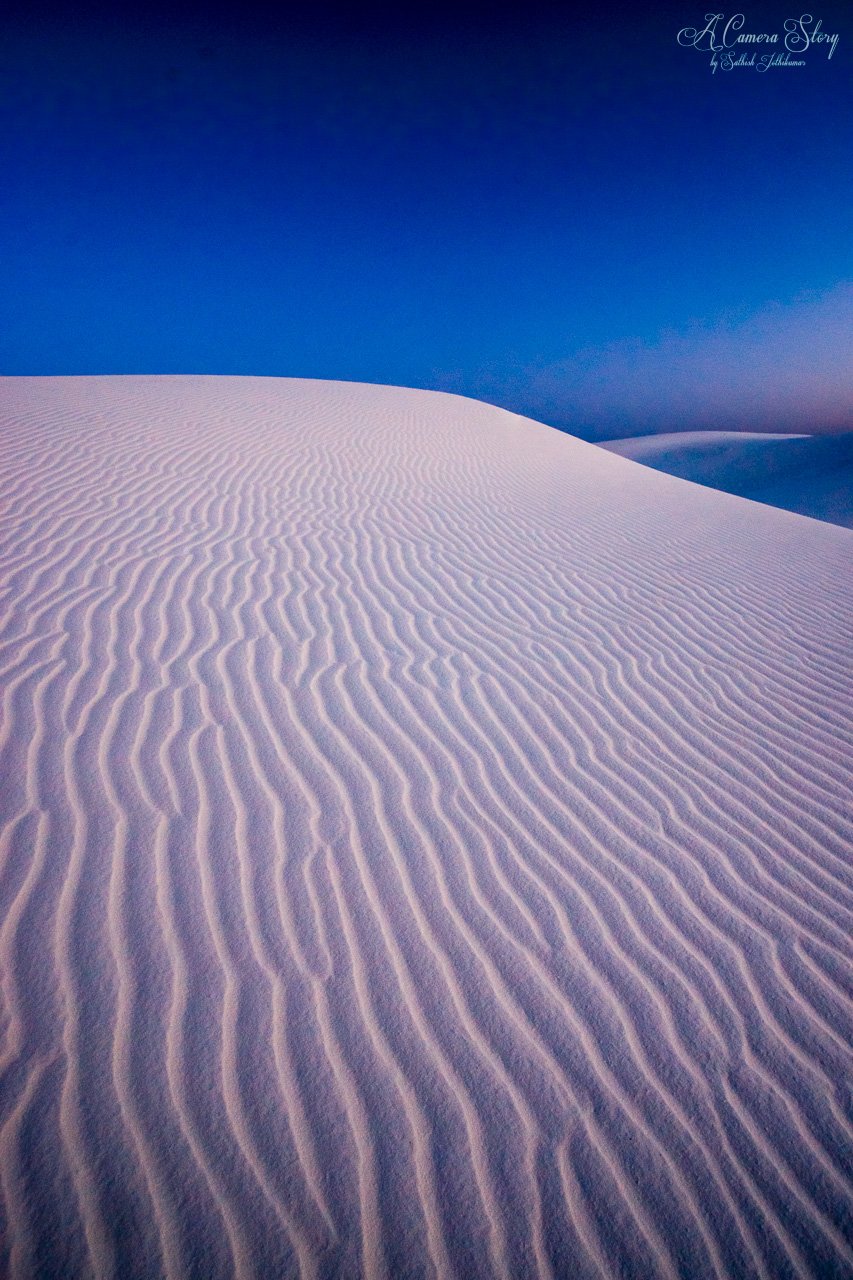Sculpted by wind and time, the ancient sentinels of Monument Valley stand as testament to the rugged beauty of the desert southwest. Their stoic presence speaks of resilience, whispering tales of a time when dinosaurs roamed the land. The Navajo people revere these formations, considering them sacred places imbued with the spirits of their ancestors. Gazing upon these natural wonders, we are humbled by the enduring power of nature and the vastness of time.
Monument Valley Navajo Tribal Park
Navajo Nation USA
Lines in the Sand
Mother Nature's fingerprint at White Sands National Park. The delicate lines on the dunes at dawn are a mesmerizing reminder of the ever-changing desert landscape. Witnessing the hues in the sand transition to warm to cool colors at dusk, and reverse again at dawn, was a big factor to decide to camp in the park. And it was worth every ounce of sand I discovered in the tent and backpack thereafter.
White Sands National Park
NM USA
Spring Thaws
California's magic unfolds as spring awakens Yosemite Valley. As snow-capped peaks begin to shed their winter coat, waterfalls roar to life, valleys become temporary lakes, and wildflowers paint the meadows in vibrant hues.
Yosemite National Park was one of the very first National Parks I had visited, and it's everlasting beauty played no small part in awakening my spirit of conservation. I hope that it inspires you to protect the rich diversity of this planet as well.
Yosemite National Park
CA USA
Meltwater
The spring thaws in the mountains bring about unpredictable dangers in the mountains. The warming temperatures thin the ice on frozen lakes, while meltwater gushing under snowbridges start weakening them. Cornices and avalanche slabs start to lose their strength and easily give way under the weight of a backcountry skier. All of these make it more challenging to traverse snow-capped mountain ranges in this transitional period.
And just like this picture, while it may seem like a pristine winter wonderland, the hidden dangers lay beneath the surface during spring.
Inyo National Forest
CA USA
Kiwi-scapes
Even though my Kiwi adventure was many years ago, it happened right around the time my fascination for the tales of Middle earth were peaking. Being able to visit many places popularized by the LOTR movies was a dream come true. I was absolutely impressed by the scale of the Alps, and the sheer number of hiking opportunities available, weather notwithstanding. It was no wonder that the South Island of New Zealand was perfectly capable of representing the diverse terrain featured in the movies.
South Island
New Zealand
Faces of DeVa
Picture a desert and the first vision that crops up is that of sand dunes stretching endlessly to the horizon. Undisturbed ripples of golden stand wiggle their way on the windward side, forming patterns akin to life-sized fingerprints. Mesquite Sand Dunes in Death Valley National Park is a classic example of this. But the park also features a vast low-level basin that are filled with white salt-flats. The salt flat is the remnant of an endorheic lake that dries out by late spring, leaving behind hexagonal patterns of crystallline salt.
Death Valley is more than just sand dunes and salt flats. But these are two key faces of this DeVa.
Death Valley National Park
CA USA
Spring Storms
The month of April often draws thunderstorms and sudden squalls to western Washington, drenching the landscape and drawing away in a very short time. The primary driver is the rise temperatures in the western Washington as the days become longer. Regardless of the reason, the onset of this weather pattern paints the skies with dramatic clouds and lighting that lend themselves well to photography.
Out in the Palouse region, I caught the tail end of a spring thunderstorm. This composition juxtaposing windmills on a rolling green landscape against the dark ominous background worked very well with the angled lighting of the late afternoon.
Palouse
WA USA
Remnants of Winter
The false summer that the PNW underwent over the last week certainly gave a taste of the next few months. But in the mountains, the winter is still hanging around. The higher elevations still hides pristine snow-capped landscapes that would continue to draw winter adventurers up to the mountains for a few more weeks.
Mount Rainier National Park
WA USA
A Dante'ing Sunrise
Getting to Dante's view in Death Valley requires driving on a twisty mountain road from near the lowest point on the continent. And trying to get to this spectacular view point at sunrise requires commitment of a different sort. And yet, I was able to convince my entire family to wake up at dawn and make our way to the freezing summit at Dante's view to catch the sunrise.
Thankfully it did not disappoint. It was cold, windy, and extremely colorful. The eastern sky slowly changed from crimson to pastel tinges as the sun cleared the horizon. At the same time, shafts of light lit up the the mellow eastern slopes of the Panamint range, lighting the highest point in the National Park. Down below was Badwater basin, a salt flat at the lowest point in the Park that served as the drainage for the elongated valley.
It was very hard to take it all, especially with freezing winds blasting from the east. But it was worth the trip.
Death Valley National Park
CA USA
It's still winter
The PNW might finally be warming up for spring. Or not.
It has been an unusual winter so far: a warm dry January, followed by a normal February, and then a cold and wet 2 weeks in March. And then an abnormal heat wave. While the El Nino has had an impact on the winter weather of the PNW, the upcoming weekend is going to break all spring temperature records. Its not only the Seattlites who probably are going to be befuddled and get sunburnt by heading outdoors, even the spring blossoms are likely to get disoriented.
Regardless, hiking outdoors may not all be sunshine and rainbows. There is still snow on the higher elevations. And the higher temperatures may lead to higher avalanche risk as well. Watch out.
Mount Baker Snoqualmie National Forest
WA USA













